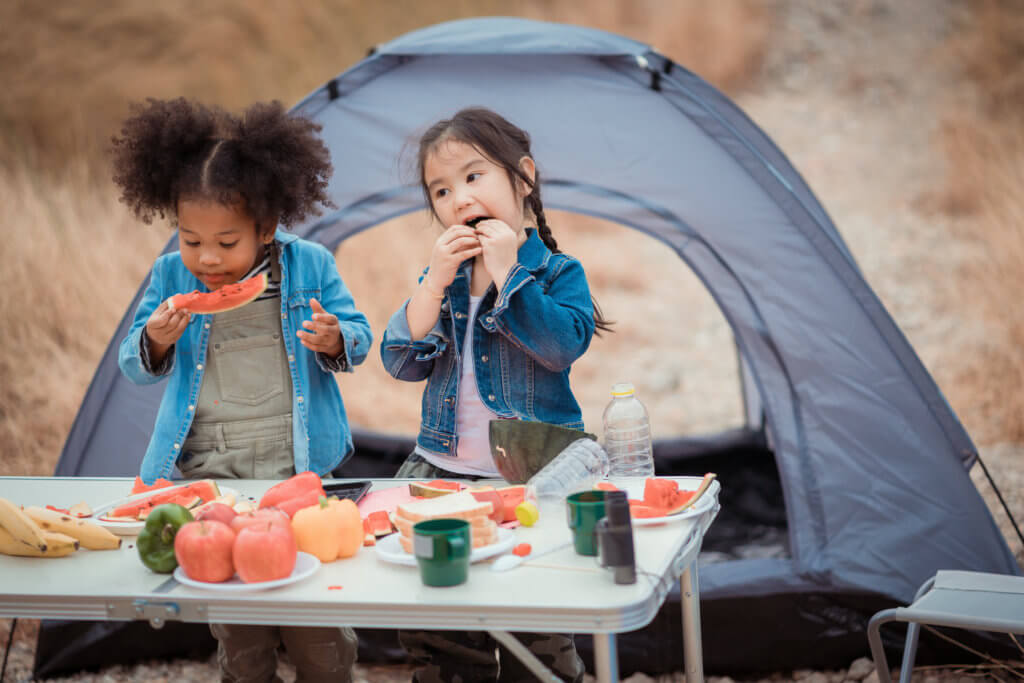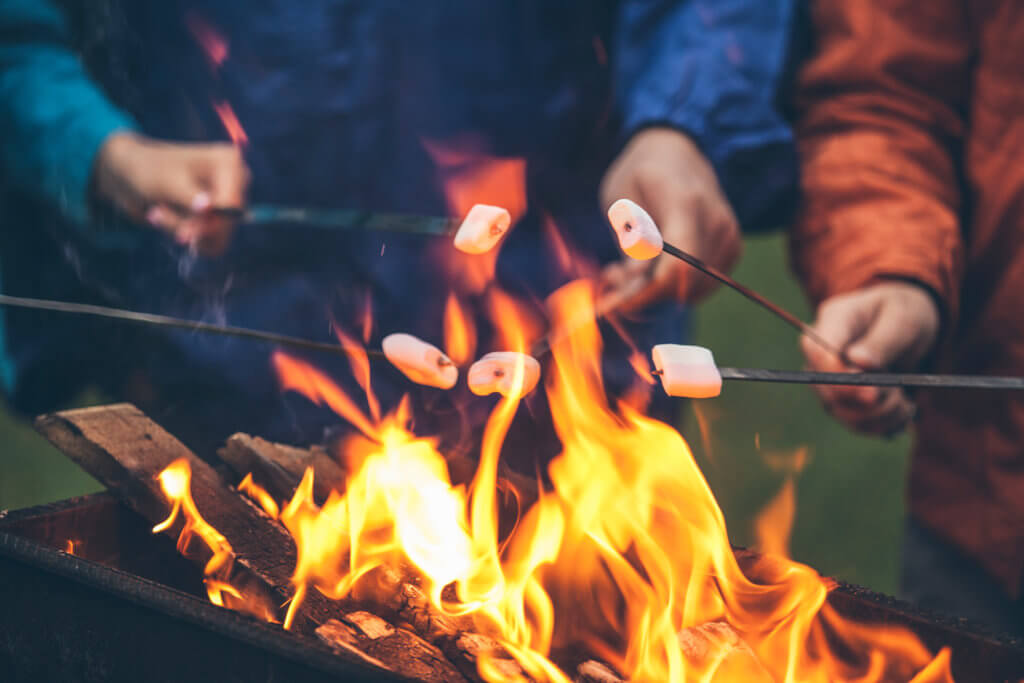Summer is just around the bend, which means it’s time to pack up the tents, sleeping bags, camp stove, kids, dogs and s’mores ingredients and head to your favorite trailhead or campsite for some summer backpacking or camping. When you do, it’s important to know the safety precautions you and your group should take when cooking at a campsite to avoid camping injuries. Below, we take a closer look at fire safety, proper cooking sanitation, plus a few of our favorite fireside recipes.
Fire Safety Tips While Camping
It might not be the first thing that comes to mind when you head into the woods, but camp cooking safety, campfire safety, food safety and proper sanitation are all important things to be aware of and prepared for. Make sure to pack a first aid kit complete with antibiotic ointment, bug repellent, bandaids, tape and other ways to treat minor cuts and burns.
First, make sure campfires are allowed where you’re camping.
The U.S. Forest Service posts fire danger signs, campfire closures and other restrictions at most U.S.F.S. trailheads and campgrounds. This also applies to national and state parks. If you’re heading out into less regulated public lands, make sure you’re on the up-and-up on current wind and weather conditions and fire safety restrictions.
If there’s a designated fire pit, make sure you’re using it.
These are designed to keep campfires as contained as possible. If there isn’t a fire pit, you’ll want to make your own. Gather up some larger rocks and make a circle. Try to minimize spaces where sparks might sneak out. Build your fire pit away from tall grasses, ideally on a rocky or sandy surface that won’t catch fire itself.
Use local firewood.
Do your best to prevent spreading non-endemic bark beetles or other diseases that can be harmful to local forests. Gather wood nearby, or, if you’re car camping, grab a stack of firewood from a local camping goods supply store.
Be mindful of kids, pets, puffy jackets, camp chairs and footwear.
Of course, kids and pets take priority. Be careful not to let your smaller campers or furry friends get too close to the flames. Also be aware if you’re wearing a down jacket or other material that is considered flammable or is prone to sparks burning a hole straight through. The same goes for footwear. It’s nice to sit back and relax and put your feet up on the fire pit, but the result might be some ruined soles by the end of your adventure.
When you’re done, extinguish the fire completely.
Stir the ashes to help them burn down as much as possible. If you don’t have access to extra water you can dump on the late-night flames, cover the coals with sand or dirt to prevent the fire from spreading.
Food & Cooking Safety Tips While Camping
Cook safely at the campfire.
While there’s no question that food tastes better when camping, it’s still important to follow a few food safety rules to minimize injury and illness while in the backcountry.
Keep those hands clean.
The kids might roll their eyes when they see the handwashing station made it all the way to the campsite, but it’s just as important – if not more – when medical help is potentially farther away. Set out some biodegradable soap, a water jug, hand sanitizer and wipes or paper towels in an obvious spot. Make sure everyone in your group knows where to find it and how to clean their hands properly.
Make sure hot foods stay hot and cold foods stay cold.
One easy way to do this is to pack a meat/food and internal thermometer. You want to avoid the “danger zone,” which is 40°F – 140°F. Bacteria love this temperature window and can multiply quickly in foods that are allowed to get a little too warm, or cool to a lukewarm temperature too quickly. This is an important consideration when you’re both cooking and storing foods. Keep the internal thermometer in your ice chest and use the food thermometer to check reheated or freshly cooked foods. Make sure to cook beef, pork and lamb until it reaches 160°. Poultry should be cooked to 165°. Allow meat to rest for at least three minutes before carving or eating.
Use separate cutting surfaces for raw meat.
Camping doesn’t always allow for lots of preparation space, but it is important to avoid contaminating foods such as fruits and veggies with raw meat. If you’re limited to a single cutting board, chop the fruits and veggies first. After you’ve cut the meat, make sure to disinfect the surface thoroughly.
Be careful with sharp knives.
This applies both to keeping them out of reach of small children and away from wagging tails, as well as to ensuring they’re cleaned properly after every use.
Use a bear box.
If you’re camping in bear country, make sure to pick up a bear box at the visitor center or trailhead before your trip. If you’re not car camping and can’t keep your food safely stored in a vehicle at night, you definitely want to store it in a bear box. Some campgrounds provide these built-in onsite. Others provide one. Regardless, they’ll help keep you and the bears safe. Keep in mind that simply storing food in a tent is not advised.


Choose your healthy journey to receive the information you want to reach your goals.
Aspen Valley Hospital has a wealth of classes, events and workshops to educate and empower our extraordinary community as we reach the summit together.
Campfire Recipes
And now, the fun stuff! Here are a few favorite campfire recipes.
Savory Campfire Vegetable Recipe – Two Ways
There’s something about campfire veggies that makes even the veggie adverse turn the corner. And, they’re easy!
- If you’re car camping:
- Pack an iron skillet or dutch oven. If possible, you can chop the veggies before you leave the house to save yourself some campside prep time. In the skillet, mix together:
- Ears of corn, cut into 2” pieces
- Zucchini, sliced
- Sweet onion, sliced
- An assortment of peppers, sliced
- Broccoli or cauliflower, cut into bite-sized pieces
- Drizzle the veggies with olive oil
- Sprinkle it with salt and pepper and your favorite spice flavors. Paprika is a common favorite, but a little garlic powder or red pepper flakes are also great.
- If using a skillet, saute over a medium fire until the veggies begin to soften and char. This will probably take about 10 – 15 minutes depending on how hot the flame or coals are.
- If using a dutch oven, follow the same steps as above, but add about ¼ – ½ cup water and then cover the veggies. Let them steam until fork-tender.
- Scoop and serve!
- Pack an iron skillet or dutch oven. If possible, you can chop the veggies before you leave the house to save yourself some campside prep time. In the skillet, mix together:
- If you’re backpacking:
- Swap the skillet or dutch oven for pieces of foil. Double the foil if you need to to make sure it can hold 2 – 3 cups of seasoned veggies and olive oil. Set the veggie-filled foil packets close enough to coals that the veggies will begin to cook, but not close enough they’ll burn. This can take some testing, but be careful to use tongs, sticks or an oven mitt to adjust the placement of the foil packets. Once fork-tender, serve and enjoy!
Breakfast Burritos
These are great not only for their flavor, but also because you don’t have to get multiple dishes dirty when making and eating them.
- In a skillet or campstove pan, cook up some sausage or veggie sausage. Once done, place on some foil and wrap to keep warm.
- In the same pan (dispose of any excess oil if needed, but make sure there’s still enough to avoid eggs sticking to the bottom), add eggs (about 2 per person). If you prefer, add some cheese for “cheesy eggs.” *Tip: If backpacking, you can crack eggs into a lightweight plastic bottle before you leave the house.
- Once the eggs are scrambled, sprinkle them with salt and pepper. Add to the sausage foil and rewrap to keep warm.
- One at a time, heat a flour tortilla in the pan. Flip once.
- Fill each burrito with the sausage and egg mixture. Add hot sauce, salsa, sour cream or any other tasty complements.
- For extra credit, you can also cook up some potatoes or quick-and-easy hash browns and add them to the sausage and egg mixture before wrapping. Enjoy!
S’mores
Obvious? Sure. But completely necessary to any successful family camping trip? Absolutely! If you want to mix it up, consider adding some fun twists to the classic.
- First, get the ingredients ready.
- Split a graham cracker in half.
- Find a stick with a sharp end or use a marshmallow roaster.
- Place a 1” x 1” piece of your favorite chocolate on a piece of graham cracker.
- Roast the marshmallow. Techniques vary widely here. Do you like a slow-roasted, golden brown mallow? Or are you more of a charred-on-the-outside, gooey-on-the-inside type?
- Once roasted, carefully place the marshmallow on the chocolate and use the remaining piece of graham cracker to sandwich the three ingredients together.
If you want to mix it up, try adding some new flavors to your s’mores. Some modern takes on the campfire dessert classic include:
- Strawberry slices
- Banana slices
- Peanut butter
- Bacon
- Caramel
- Nutella instead of chocolate
This summer, stay safe and keep the campfire fare savory, sticky and fun!


